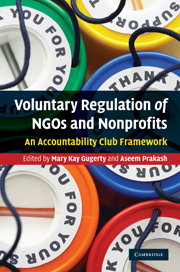Book contents
- Frontmatter
- Contents
- List of figures
- List of tables
- Notes on contributors
- Preface
- The club framework
- Part I Club emergence
- 2 Filling the gaps in nonprofit accountability: applying the club perspective in the US legal system
- 3 Trends and patterns in third-party accreditation clubs
- 4 Self-regulation at the state level: nonprofit membership associations and club emergence
- Part II Club sponsorship and club design
- Part III Club design and effectiveness
- Future research and conclusions
- Index
- References
3 - Trends and patterns in third-party accreditation clubs
from Part I - Club emergence
Published online by Cambridge University Press: 10 November 2010
- Frontmatter
- Contents
- List of figures
- List of tables
- Notes on contributors
- Preface
- The club framework
- Part I Club emergence
- 2 Filling the gaps in nonprofit accountability: applying the club perspective in the US legal system
- 3 Trends and patterns in third-party accreditation clubs
- 4 Self-regulation at the state level: nonprofit membership associations and club emergence
- Part II Club sponsorship and club design
- Part III Club design and effectiveness
- Future research and conclusions
- Index
- References
Summary
An important group of accountability clubs are accreditation clubs. These clubs try to influence the behavior of member organizations using tools ranging from codes of conduct to intensive and sophisticated accreditation processes. This chapter uses the club framework developed by Gugerty and Prakash in this volume (chapter 1) that combines an agency perspective on accountability with club theory and signaling theory to describe the various types of voluntary standard-setting and enforcement in the nonprofit sector. The particular focus of this chapter is on the health and education sectors in the United States where such clubs are quite prevalent. A principal who delegates a task to an agent has a right to expect the agent to perform according to her specifications. When the self-interests of the principal and her agent diverge, as they often do, the agent has an incentive to shirk. Asymmetric information between the general public and its agent (a nonprofit) places the public at a disadvantage in giving, volunteering, and seeking service. Asymmetric information is a fact of life where the most important characteristics of services are not readily observable and/or not easily evaluated by lay persons – as is typical of education and healthcare services. Gugerty and Prakash identify competence asymmetry as an additional component of the information problem. Even if one has information on an organization, one might not be able to evaluate competence as it is unclear how well that information measures organizational competence.
- Type
- Chapter
- Information
- Voluntary Regulation of NGOs and NonprofitsAn Accountability Club Framework, pp. 64 - 84Publisher: Cambridge University PressPrint publication year: 2010
References
- 3
- Cited by



